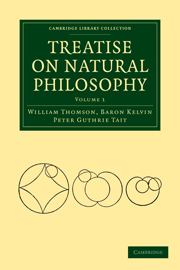Appendix to Chapter I
Published online by Cambridge University Press: 07 September 2010
Summary
Ao.—EXPRESSION IN GENERALIZED CO-ORDINATES FOR POISSON's EXTENSION OF LAPLACE's EQUATION.
(a) In § 491 (c) below is to be found Poisson's extension of Laplace's equation, expressed in rectilineal rectangular co-ordinates ; and in § 492 an equivalent in a form quite independent of the particular kind of co-ordinates chosen : all with reference to the theory of attraction according to the Newtonian law. The same analysis is largely applicable through a great range of physical mathematics, including hydro-kinematics (the “ equation of continuity” §192), the equilibrium of elastic solids (§734), the vibrations of elastic solids and fluids (Vol. II.), Fourier's theory of heat, &c. Hence detaching the analytical subject from particular physical applications, consider the equation
where p is a given function of x, y, z, (arbitrary and discontinuous it may be). Let it be required to express in terms of generalized co-ordinates, the property of U which this equation expresses in terms of rectangular rectilinear co-ordinates. This may be done of course directly [§ (m) below] by analytical transformation, finding the expression in terms of, for the operation. But it is done in the form most convenient for physical applications much more easily as follows, by taking advantage of the formula of § 492 which expresses the same property of U independently of any particular system of co-ordinates. This expression is
where ∬dS denotes integration over the whole of a closed surface S, ∭ dB integration throughout the volume B enclosed by it, and δU the rate of variation of U at any point of S, per unit of length in the direction of the normal outwards.
(b) For B take an infinitely small curvilineal parallelepiped having its centre at (£, £', £“), and angular points at
Let be the lengths of the edges of the parallelepiped, and a, a', a” the angles between them in order of symmetry, so that R'R” sin, are the areas of its faces.
Let DU, D'U D“U denote the rates of,variation of U, per unit of length, perpendicular to the three surfaces £= const., £' = const., £” = const., intersecting in (£,£', £“) the centre of the parallelepiped.
- Type
- Chapter
- Information
- Treatise on Natural Philosophy , pp. 160 - 218Publisher: Cambridge University PressPrint publication year: 2009First published in: 1883

